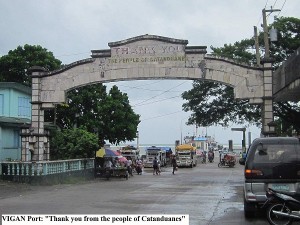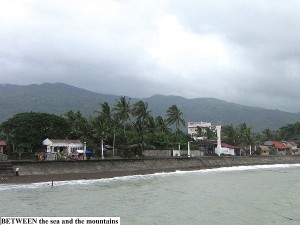Governor’s challenge: How to raise Catanduanes’ low income
 The island province of Catanduanes, three hours by ro-ro vessel from the Bicol mainland, is high in ecotourism potential but low in income because it confronts the winds and turbulent waters of the Pacific Ocean.
The island province of Catanduanes, three hours by ro-ro vessel from the Bicol mainland, is high in ecotourism potential but low in income because it confronts the winds and turbulent waters of the Pacific Ocean.
How to raise the province’s income? “We are 90 percent dependent on the IRA (Internal Revenue Allotment),” says Gov. Joseph C. Cua, a commerce graduate of the Philippine School of Business Administration in Manila, and now on his second term.
“I focused on health and income-generating projects for the government,” he adds.
At the beginning of his term, he availed of an electronics systems data donated by Legazpi City in Albay, focused on tax collection; and the provincial government was able to achieve 300 percent increase here.
Tourism is another challenge. “The only way we can develop tourism is through infrastructure,” Cua notes. “Mahal (expensive) ang infrastructure. We need millions to develop infrastructure, so we need DOT (Department of Tourism) National here.”
A glossy EZ MAP-travel brochure of Catanduanes represents a P300,000 investment of the provincial government. Here you have a detailed map of the capital of Virac, major roads and distances; hotels, resorts and restaurants; and tourist attractions.
 Malls are a barometer of progress, the governor observes, and so a high-profile, flagship project is the Center Mall, which is in front of the fountain memorial to Catanduanes’ Unknown Soldier and near another mall, the Century Family Mall.
Malls are a barometer of progress, the governor observes, and so a high-profile, flagship project is the Center Mall, which is in front of the fountain memorial to Catanduanes’ Unknown Soldier and near another mall, the Century Family Mall.
Sports complex
The property used to be a youth sports complex badly in need of repair, in short, an eyesore, so the provincial government took over and invested P100 million in its rehabilitation.
“The funds came from a loan and from development funds,” Cua says. Legal issues with the municipal government of Virac were eventually threshed out, stalls were rented out and now the project is nearing completion—and earning. Jollibee is in town, along with the recent Chic-Boy. What, no Chow King?
“That’s for phase two,” the governor says imperturbably. No sign of McDonalds yet.
“If you invest tataas ang halaga [the value will increase],” Cua points out. “May income ka pa [and you earn].”
Another venture of the provincial government was the Catanduanes Hospital, backed up by a P100 million program of the Department of Health. The facilities were strengthened, more patients came in, and the government-owned hospital was converted into a free enterprise. After two years, it began to earn P30 million a year.
“May income na siya,” the governor notes, “so the savings from the subsidy can go, say, to the barangay [villages].”
A Dialysis Center was also established under a joint venture with a private hospital.
The main product of the province is abaca and “we need to mechanize,” the governor asserts. “We need big-time mechanization. It took Davao 50 years to achieve this, and Leyte 15 years. I’m only in fourth year.
That is the only way to help the farmers, it will increase their income three-fold.”
It is hard to train farmers to strip abaca, however. Some are cautious because with one slip you may lose a finger or a hand. “But some are already learning,” Cua reports. “Tuwang-tuwa ako (I’m very happy) so we are still hoping.”














